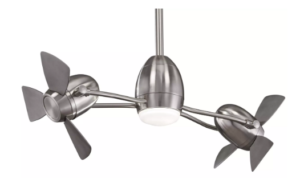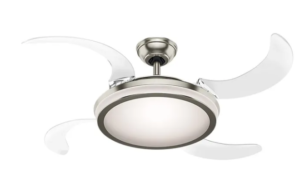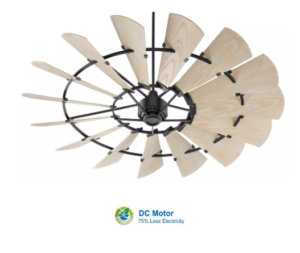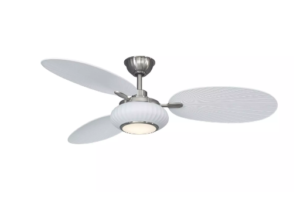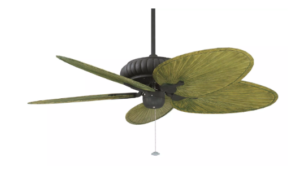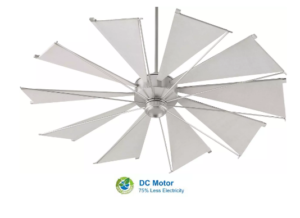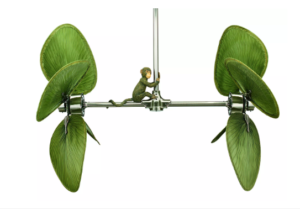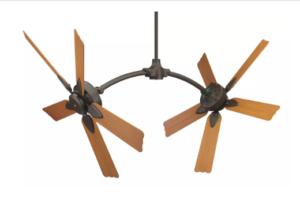We reviewed hundreds of products to find you the very best unique ceiling fans. We selected fans of all sorts of shapes, sizes, and styles to bring you an eclectic array of choices. Our assortment below includes belt driven fans, tropical style fans, dual motor fans, and windmill fans. There is something for everyone in this article. We hop you like it!
The Minka Aire Cage free Gyro ceiling fans have a brushed nickel finish body with silver color blades. The popular gyro design features an integrated 17 Watt LED light fixture. This dual head style indoor ceiling fan operates by a 3 speed wall control with a full range light dimmer. Without lights, two AC motors consume only 45 watts per hour.
Two sets of adjustable Gyro cages can fold up to 90 degrees or parallel to the floor. The fan heads move up or down to get multi- directional airflow. With 2726 CFM airflow capacity and multi directional rotating blades in action, you get great air circulation for all seasons.
Minka Aire is known for re-hashing popular designs into more innovative and radical versions. The modified popular gyro cage design eliminates the cage to give precise control and intense airflow. It could be a perfect addition to your interiors.
The Hunter Fanaway is a retractable indoor fan whose 48″ blades come out only when in use. How unique is that! The rest of the time, it gives an illusion of a single minimalistic light fixture. This small fan has 15 degree blade pitch and requires a 5″ downrod for installation. The fan provides optimal performance in small spaces that requires minimum cooling.
Installation in irregularly shaped spaces is easy with its sloped ceiling adapter. That means it can be installed on un-level ceilings. The 153x 15 mm WhisperWind DC motor gives a long hour performance without any hassle. The powerful motor is quiet and energy efficient. You get multiple operating controls as well. Given the unique model, it’s not going to blow your socks off with windspeed. However, this fan is a great modern design and an excellent addition to a modern looking room that requires only moderate cooling.
Hunter fans feature unique designs. They are the first ones to promote ceiling fans in the market a century ago. The Fanaway series is one of the most innovative fans from Hunter designed with clear blades to blend with your décor effortlessly.
The windmill style Quorum ceiling fan with its weathered oak blades exudes rustic aesthetics. Use it both indoors and outdoors to uplift any kind of contemporary or traditional décor. For a noise- free operation, the model features an energy efficient 165LT DC motor. You get a strong cooling breeze with a 30 degree blade pitch and an airflow rating of 6486 CFM.
The versatile fan is available in two models – the damp rated outdoor model and the dry rated indoor model. Optional blade spans of 44”, 52”, 60” and 72” will suit rooms of all sizes. With optional lighting fixtures and controls, it offers a large window of customization.
The Quorum fans are a go-to for any room decor. The Windmill styles fans are here for years. Infact, they were the first to introduce such a style to the market. Additionally, with a lifetime limited warranty on the motor, you can rest assured of a quality purchase.
The Counter Fandelier from Maxim is the best lighting integrated ceiling fan on the market. The dimmable LED light produces an intense 9315 lumens color brightness but consumes only 56 watts of power. The illumination produced is equivalent to an incandescent bulb of 500 watts but at half the cost.
Its over-the-top wind speed factor (11.71 MPH Vs 3 MPH avg) will blast you with air. As a result, you experience a strong cold breeze and an intense wind movement across the room. A decent ventilation comes promised, thanks to its above-average 5057 CFM airflow. The fan is not for outdoor areas but is sure to benefit any large room inside. It’s modern and unique design make it great for any new home in need of some cooling.
Maxim is known for its trendy designs for almost five decades now. The Counter Fandelier is one of their 4000 distinct designs to complement any type of room decor. Their designs are so minimalistic yet intricate without compromising on quality and performance.
The 56” blades of the Fanimation Palma are ideal for small to medium size rooms. The matte white finish with composite petal designed blades adds softness to your décor. With a 13 degree blade pitch, the fan provides 3.31 MPH of wind speed. It gives moderate soothing breezes and will suit spaces with minimal cooling needs.
The 6508 CFM of airflow will ensure the room is well ventilated and aired out at all times. The efficiency at 86 CFM per watt and 49 to 162 RPM will not raise your AC bills. Its UL damp rating and integrated LED Lighting for terrific illumination makes it appropriate for outdoor areas..
Fanimation produces durable pieces that also have timeless designs. Most of their products are versatile and complement aesthetics of varied environments. The Palma range is one of those classic designs that wont dig a hole in your pocket but will serve consistently for years.
The Fanimation Belleria gives a unique and tropical vibe with its narrow palm oval blade design. The traditional 3 speed pull chain adds charm to its overall design. Other control options are available for your convenience as well. The composite blade designs with a 20 degree blade pitch gives an overlapping effect when turned on.
The optional light fixtures and blade spans ranging from 48” to 60” give you the ability to customize exactly what you want. The 188mmx 25mm AC motor makes it very affordable and easy to use. The slightly above average 3.23 MPH wind speed is ideal for moderate cooling requirements. The five blades rotate at 65 to 163 RPM (revolutions per minute) giving instant strong breeze.
Fanimation is one of the first brands in the market to bring unique fans at affordable price. The palm leaves blades of the Belleria are available in different finishes to make your décor visually attractive but wont let you down in performance.
The Quorum Mykonos windmill ceiling fan is available in 52”, 60”, 72” and 92” blade spans. Its large size suits living rooms and reception areas the best. The non-rigid canvas blades provide low RPM leading to a low and moderate cooling breeze. Hence, spaces with less cooling needs will be ideal for this model. However, the larger the blade span, the more wind speed and better cooling effect you’ll get with this unique windmill style ceiling fan.
The model consists of a 6 speed wall control and a handheld remote for operation. The contemporary design with an 18 degree blade pitch gives decent wind circulation. This is strictly an indoor fan with optional light fixtures.
Quorum fans have been in the business for 35 years and own over 1200 unique fan designs. Their award winning customer services and designs have made them the most sought after brands in the recent times. With the Mykonos series you get impressive style and quality that is standard for Quorum.
The Fanimation Palisade is an attractive tropical style ceiling fan with dual – vertically rotating motors. It’s quite a unique take on a ceiling fan! Blades are at 40 degree blade pitch available in different sizes that require specific downrods for installation. A 30” downrod is required for 22” blades and a 24” downrod is required for 18” blades. The downrod options make it suitable for all kinds of ceilings and so that the blades don’t hit your ceiling while rotating.
The fan mainly operates by a 2- speed white slide wall control but other controls are also available. You need to manually control the switch on each motor to use reverse airflow. With optional light fixtures this model is made for indoor use and outdoor covered areas.
The Fanimation tropical fans are one of the most sought after fans among customers. The palm leaf style designs are available in different finishes to suit your décor better. Fanimations palm leaf style fans are some of the most efficient and affordable ones in the market with better customization options.
A dual head ceiling fan, the Caruso is available in different angles from 60 degrees, all the way to a vertical orientation. This fan can be customized choosing a variety of tropical or traditional style fan blades. The model also allows customized light fixtures you can add on each end or to the center of the fan for added style and function.
This versatile fan is suitable for both outdoors and indoors in either dry and damp locations. With a 188 x 25 mm AC motor, it becomes very light weight and affordable. The device is operated under various types of controls but primarily used by a 3 speed wall control.
Anyone looking for trendy or quirky designs on a budget knows about Fanimation’s huge library of such products. The Caruso offers customization in almost every part which allows you to match the fan with your décor in a more personalized manner.
As an affiliate partner, we may earn from qualifying purchases made on these products.
A Ceiling Fan Buyer’s Guide: Everything To Know When Buying a Ceiling Fan.
We have a deep love for ceiling fans and live to help others understand these products as well as we do. That is why we took the time to write a unique ceiling fan buyers’ guide.
Buying a unique ceiling fan for the first time can be overwhelming. There are many options for fans and each fan has different styles, sizes, functionality, blades, and installation steps.
Fortunately for you, we have distilled all of the key variables down into an accessible and digestible guide. You can read this guide if you want an in-depth understanding of ceiling fans or you can skim it if you only want to better understand certain aspects of the fan itself.
This includes how to select a fan to buy, the types and angles of a fan’s blades, the pros and cons of the AC and DC motors that power fans, and how to install the fan on your ceiling. If you follow this guide you can be confident that you are making a well informed buying decision.
We know all things ceiling fans and want to pass on our learnings and insights to help you.
Most importantly, we know that once you evaluate, select, and install a ceiling fan it will likely remain in place for many years to come. That is because ceiling fans can be heavy, expensive, and labor intensive to install.
What makes a fan unique?
Given how many fans we interact with – and the hundreds on this site alone – we have seen our fair share of cool, different, and compelling designs. Our definition of unique includes:
- The fan has a unique blade pattern.
- The fan has a unique downrod, base, or design.
- The fan is one of a kind.
Take the time to do research now before buying because the switching costs of changing your mind can be high.
Go through this evaluation check-list so that you better understand the types of motors, blades, installation units, and fans that exist. We encourage you to optimize for:
- Overall quality: in particular the speed of the motor to optimize for cooling efficacy and quietness.
- Aesthetics: in particular ensure that you are happy with how the fan looks, its color, shape, design, and blade count.
- Size: select the right size fan for the room you will be placing it in. Larger rooms require larger fans to create strong air flow.
Selecting the location of a unique ceiling fan: Inside or Outside
Most unique ceiling fans are used within the home. Others are for outdoor structures. Before deciding which type of fan to buy, determine where you will place it. Understanding the placement of a ceiling fan will help you select other attributes – like size, speed, and sound – that will enhance your experience with the fan.
Unique outdoor fans require different electrical strategies and water-proof finishes. Please keep this mind throughout the guide as we largely focus our attention and advice to those people who want to install indoor fans.
If placing the ceiling fan in an indoor room, measure the size of the room.
Bathrooms tend to be smaller than bedrooms which tend to be smaller than living rooms or kitchens.
Knowing the approximate size of the room in which the unique fan will be placed is important.
Larger fans are best suited to larger rooms as their blades and motors move greater volumes of air.
Ceiling Fan Size Chart
| Room (in feet) | Cubic Feet/Minute | Fan Size |
| 6′ x 6′ | 3,000 – 4,500 | Shop: 24″ to 36″ |
| 10′ x 10′ | 4,000 – 5,500 | Shop: 37″ to 48″ |
| 12′ x 12′ | 6,200 – 7,500 | Shop: 49″ to 56″ |
| 15′ x 15′ | 7,000 – 9,000 | Shop: 60″ to 72″ |
| Larger | 9,000 – 11,000 | Shop: 80″ to 99″ |
The length of the blade of the fan and the size of the room go hand in hand.
In short, if you have a large room, buy a larger fan. The bigger the fan the better.
The common sizes for ceiling fans are 36, 44 and 52 inches, with the large fans having a blade wingspan of 60 inches.
Of course you can technically go even larger, with the largest recreational home fans having up to 99 inches of wingspan.
99 inches is 8.25 feet. That is a large fan indeed.
Measure the height of the ceiling and allow at least 7 feet and 6 inches of space.
It is wise and safe to place your fan at least 7 feet above your flooring.
Placing a ceiling fan high up protects tall individuals from hitting their head or having their hair caught while the fan is in motion. Fans need to be installed on ceilings and these installation bases take space as well.
An installation base is adjoined to a downrod, which is a simple piece of metal that the fan is connected to and hangs from.
The average American ceiling height today is 9 feet (2.7432 meters). This means that the average room can support a fan but with a shorter downrod.
If you have average sized ceilings you can afford to install no more than 1 foot and 6 inch downrods.
How to measure downrods and base mounts
A ceiling fan is composed of fan blades, a downrod, and an installation base.
The installation base attaches to the ceiling. The downrod connects to the base. And the fan itself hangs from the downrod.
Per the measurements mentioned above, the fan must be at least 7 feet and 6 inches above the ground if you have a standard 9 foot ceiling.
There is one exception: fans placed above beds, where you will not walk, require less height.
Many people enjoy selecting the fit and finish of the downrod as these pieces of metal or plastic come in different colors, shapes, and sizes and compliment the overall fan’s aesthetic.
As a general rule, more expensive ceiling fans enable you to have longer and more customizable downrods. The downdrods tend to be longer – between 6 and 18 inches.
This is for functionality and aesthetics. Cheaper ceiling fans sometimes have very short – or almost nonexistent downrods – because the base and the fan are fused together.
Design and Look: What to Think About the fan’s general aesthetics
A hugely important aspect of a ceiling fan is what it looks like. If you see the fan while lying in bed or while in your living room you will want it to look great. All unique fans have a special look and feel to them.
The base and downrod are not nearly as important as the blades for how a fan looks in a room.
Blades come in different cuts, lengths, seizes, finishes, colors and of course quantities.
How many blades should the fan have?
At a minimum, most ceiling fans will have two blades though four or five are certainly more common.
A two blade fan can be made of one long piece of metal connected at the mid-point or two distinct blades.
But some special unique fans have just one blade. This type of fan produces less air flow than a multi-blade fan but can still look great and be functional at the same time.
One type of ceiling fan, called a windmill fan, can have upwards of 20 blades packed tightly together. These fans are unique and wonderful and withstand the test of time as durable relics to earlier wooden fans.
When you look at a fan that is turned on, the blades are hard to see. When the fan is stationary, however, the design and color of the blades will need to align with your preferences for style and decor.
Fans with four to six blades produce a lower pitch, softer volume noise output. Three blade fans use the air surrounding the fan most efficiently and require the least effort to clean as you have fewer blades and surface area to collect dust.
Windmill fans, always popular in kid’s rooms, have the most surface area of blades. This increases the effort to clean and dust these fans.
The color, material, and quantity of the blades impact how the fan looks and performs.
Another subtle variable is at play too: the angles of those blades. If the blades are too flat, they won’t whisk through the air and create air flows. We highly advise blades with angles between 12 and 14 degrees.
Nearly all of the fans we provide you here have angles in that range for optimal air circulation and air flow efficacy.
More than a fan: how unique fans provide lighting, symmetry, and aesthetic benefits.
Some people buy unique ceiling fans simply to cool or heat a room. Others buy ceiling fans because they can be elegant and add character to a home. Some fans have lights and others do not.
If you are going to place your fan in the center of a room – for example, your living room – you might do so at the expense of a central lighting system.
For this reason, adding lights to fans is popular. If you add lights you will want to also consider how easy it is to change the bulbs, especially if the fan is very high above your floor.
LED, Halogen, and Fluorescent lighting options are available on all fans that have integrated lighting.
Control Your Environment: Noise and Air Flow
Fans without lights produce two types of energy outputs when they are on: noise and air-flow. Both will impact your experience with the fan. Fans with lights also produce illumination as an energy output.
Firstly, noise is a byproduct of any fan. The rotation of the blades and the motor can cause distinct sounds. Larger motors produce more power and, as a result, can generate more noise.
The good news is that noise can be mitigated.
Motors that are built from higher quality and durable screws, armature, bearings, windings, and rotors are more expensive.
Cheaper fans have motors that usually produce more noise as a byproduct.
If you want a quieter fan, buy a more expensive one. You won’t regret it.
Please pay particular attention to this when considering which type of fan you will place in different rooms in your home. If you are considering a bedroom ceiling fan, it is prudent to optimize for minimal sound.
People tend to care less about noise when a fan is in a garage or bathroom.
The second type of energy output is air-flow.
Fans can not only cool rooms, they can also heat rooms and reduce air moisture.
They substitute central cooling or work in conjunction with air conditioning.
Fans do not lower air temperatures. They produce air flows and circulation which can in turn create the effect of a windchill.
The wind chill temperature is how cold people feel. The air flow, which leads to evaporative cooling (deratification), is generated by the ceiling fan.
If you are using a fan for general room cooling, you will want a fan that accelerates the heat loss from exposed skin.
Put simply, you will want a fan that generates significant air-flows point downwards and towards the center of the room.
Air Flow Deep Dive: Cubic Feet per Minute
Air flow is the volume of air that is produced by the fan.
The most common way to measure air flow is Cubic Feet per Minute (or CFM).
All of the fans we review have a CFM rating so that you can easily compare how much air that each fan produces.
The average CFM is around 5,000.
For nearly all non-industrial use-cases, like your home bedroom, kitchen, living room, or garage, a CFM of 6,000-7,000 is optimal.
At this rate you will be left feeling cooler without greatly enhancing your energy bill or having papers strewn all over the place from the powerful wind currents that larger fans produce.
You might also see a measurement similar to CFM which is air (or wind) Miles Per Hour.
Much like measuring the speed at which one drives, a fan can have its air speed measured too.
Nearly all fans produce between 3 and 5 Mile Per Hour air flows. Naturally, the higher the MPH, the stronger the air flows.
Controlling Your Fan and Your Energy Output for Efficiency
Mobile apps and the internet have changed how we communicate, manage, and control various technologies.
Unique ceiling fans are no exception.
Ceiling fans are well suited for management by a digital switch, remote, or mobile app because you can power the fans on or off (or even alter the speed) from afar.
A connected fan is controlled via a remote control or smartphone. In contrast, less expensive and simpler fans are controlled via a manual switch.
Lastly, some ceiling fans are controlled by pull chains.
While chains are usually made long enough for all users to reach them, please keep in mind that this can cause discomfort or annoyance on high ceilings or fans that need to be frequently turned on or off.
If you plan on installing your fan over 9 feet above the ground, you should buy a fan that can be controlled digitally.
All ceiling fans can create air-flows bi-direactionally.
Usually a simple switch exists on the fan’s motor or external base that enables you to change the direction in which the blades rotate.
Changing the directional air propulsion is critical during the winter months.
Rather than have air convected from the center of the room for cooling, you will want air to move from the blades horizontally down through the walls.
Lateral air-flow is used for heating rooms and maintaining central warmth while reducing your energy bill.
Choosing the right ceiling fan direction
How you control your fan is correlated with how much energy your fan uses. Will you leave it running all the time? Or will you use smart logic to power it down after a certain amount of time?
We have gone above and beyond to think about fans not just as cooling mechanisms but as a tool that can help you save money while lowering your ecological footprint. These efforts will, most importantly, save you money.
Let me explain further.
When you use central cooling or air conditioners, you are physically reducing the temperature in a room.
An air conditioner sucks air into its ducts through a vent. This air cools the gas in the evaporator and as the heat is removed from the air, it is cooled. Cool air then flows into your room.
This process is energy intensive and expensive.
In contrast, a ceiling fan does not cool the room or remove heat. Rather, it moves air around which creates the feeling of cooling. Actual cooling is not occurring. Less energy out means less energy in. And in total this means a lower energy bill.
What Unique Fans Looks Like To You and Others
This guide provides ample information pertaining to how a ceiling fan works and things you should be aware of before buying one or many fans for your home.
What we have not discussed in great depth is how a fan looks and the importance of design aesthetics.
A fan will need to fit aesthetically into your room and, as a result, you should think about material (wood, metal, plastic), color, and design patterns. Some questions to reflect on:
- Is the room light or dark? Is it naturally well lit or does it require lots of electrical light?
If your ceiling fan is going in the center of your living room, for example, you will likely want a fan with built-in lighting. This is because many living rooms have existing fixture hardware and wiring.
- Do you want a smart fan that connects with your digital applications and services (Google Home, Nest Apple Siri, Amazon Alexa)?
If you control other aspects of your home – like the temperature and humidity – via smart apps, you might want to add a ceiling fan as another connected Internet of Things device. Likewise if you have high ceilings and plan to install a fan that you can’t easily reach by hand.
Smart fans can be controlled via your phone, tablet, or voice, and these controls will make turning them on or off easier.
- Do you want a windmill fan?
Windmill fans are harder to clean (more blades means more surface area for dust to land and accumulate). On the other hand, windmill fans are quiet and elegant.
This type of fan is also hugely popular in kids rooms and living rooms.
The windmill fans pay homage to an older design aesthetic.
While this fan is not modern chic it goes very well in rooms with wooden floors or darker walls because it is made of simple plastic or wood finishes, glass fiber reinforced polyester, and thin pulp-plastic infused blades.
- What color do you want the fan? What style finish do you want? Do you want a fan with a neck belt?
Sleek and minimalist fans have fewer blades. These fans, made of lightweight metal, have universal white, grey, or black finishes.
Where to buy unique ceiling fans?
Ceiling fans are heavy and can be difficult to fit in a car or to transport yourself unless you have a large vehicle or flat-bed truck. Given this, it makes a lot of sense to have your fan shipped to you so that it arrives ready for home assembly.
You can self-install a ceiling fan. This work requires moderate technical skills and physical strength. This is because you will need to install not only the fan (the blades) but you will need to connect the fan’s base to the ceiling and its electrical fixture hardware and wiring.
How much do unique ceiling fans cost? What impacts the price of these fans?
Ceiling fans range in price from $175 on the cheap-end to over $2,000 on the high-end. There are several reasons why the range in price is so large.
A ceiling fan, made of plastic instead of more durable wood or metal, is cheaper.
Additionally, less expensive fans have weaker motors. This means that they are capable of producing less air flow or have smaller Cubic Feet per Minute scores.
More expensive fans are akin to those you would experience at a resort or high end hotel. A ceiling fan over $1,200 will likely come packed with high tech solutions built-in.
These fans will enable you to:
- Program the fan based on motion, temperature, or humidity.
- Turn the fan on or off based on preset logic or rules for maximum physical comfort.
- Enjoy very efficient and quiet DC motors that have multi-decade support and lifetime expectations.
Moreover, these pricer fans come with app based (smart phone, iPad) mobile management and remote controls.
It is common for expensive ceiling fans to come with mount options so that you can install a panel adjacent to your light switch. These wall mounts enable you to control not only the fan (on/off) but also the fan speed and direction.
Cheaper fans do not come with these in depth level of controls or sophisticated management features.
And that is ok. Simplicity might be what you crave.
Cheaper fans cool rooms as well and can be easily turned on/off with pull chains.
Less expensive fans (in the $100-$300 price point) still come with energy-efficient dimmable lightbulbs.
AC vs DC fans: Understanding a fan’s power source
Most inexpensive fans leverage AC motors.
Although AC motors are more powerful than DC motors, they typically are less efficient and are not as good at using their energy output.
This can cause additional noise (thereby making it harder to sleep if that fan is in your bedroom).
When buying a fan, please take a moment to see the Power Source listed in the fan’s essential product information that all suppliers provide. If you buy a fan with an AC motor, it will be louder.
As a result, we highly advise buying a DC powered fan if you will be sleeping near it.
AC motors are durable and longer lasting. While this might seem positive, DC motors are better (and therefore more costly).
DC motors are simpler to install into the fan’s base, have high startup power, and have a faster response time.
This means that time will be shortened from when you switch the “on” button to when the fan is accelerating to cool your room.
Although more expensive, ceiling fans with DC motors consume 70% less power which will enable you to save money over time as you pay less to power them.
Where to place the ceiling fan: voltage and flush mounting
Many people place their unique ceiling fans in the center of a room or above a bed. This is to maximize comfort and the impact of the fan’s air flows. And because unique fans are meant to be enjoyed and looked at.
Unlike an attic or garage fan, you will likely want your unique ceiling fan in the center of your home life because you will enjoy interacting with and looking at it.
A centrally placed ceiling fan also creates room symmetry.
Voltage is the pressure from an electrical circuit’s power, and the most common electrical outlet in any home is a 110 volt. If you live in the United States, you will need to select a fan that complies with this voltage limit.
Luckily for you, nearly all off-the-shelf ceiling fans support this standard.
When installing a ceiling fan you will need to get a few things absolutely right. We have done this many times for ourselves, our family, friends, and of course our clients.
Firstly, some ceiling fans support flush mount integrations. Flush mount fans sit directly against the ceiling and point downwards. These fans are typically useful for cooling a small room.
Not all ceiling fans are flush mountable.
This means that they will hang lower from the ceiling. If you buy a fan that cannot be flush mounted, please ensure that the lower point of the fan is at least 7 feet and six inches from the ground.
Additionally, ensure that the weight bearing load of the ceiling can support the fan.
Similar to voltage, this should be routine in many homes.
But it is worth investigating because you don’t want to buy a fan just to see it unable to stay upright.
For most fans that we review and see our clients deploy, a ceiling must be able to support approximately 35 pounds of downward pressure.
Buyer’s Guide Summary: Bringing It All Together
Buying a unique ceiling fan for the first time does not need to be overwhelming.
Simply follow this guide to evaluate and buy the fan that fits best in your room and adds the most value in your life.
Don’t get too bogged down in the details. If nothing else, pick a fan that looks great, fits well within your room, and that is priced according to your budget. Pick a fan that has character and is different.
Remember to install the blades last, so that they don’t break. This will be written in every installation manual.
If the fan is going into your bedroom, it is worth spending a bit more for a quitter product – you won’t regret it.


